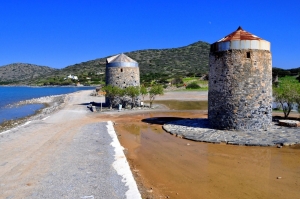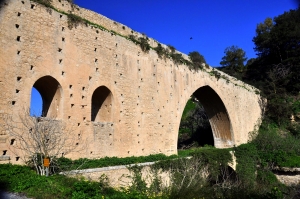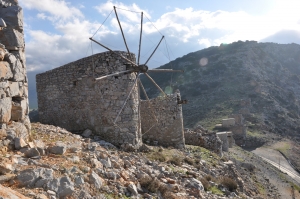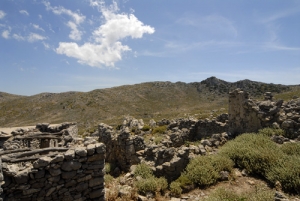Lassithi plateau hosted, after the 1950s, the first, largest and most beautiful wind farm in the world with approximately 13000 windmills with a total installed power of above 5MW. The windmills operated as pumping engines above the wells of the plain to water the crops in summer.
Contrary to the tradition of building mills on mountains, on the seaside of Elounda's ancient saltpans, we meet three windmills, at the scenic point where a canal connecting the lagoon with the south shores has been constructed. They all are completely circular, turning to all winds (this type is called Xetrocharis.
The beautiful arched bridge of Prevelis is met on the way to the homonym monastery and crosses Megas River which empties at the famous beach of Preveli. It was built in the 18th century by monks of the monastery.
The settlement of Drakos (i.e. Dragon) is located close to Limnes (Agios Nikolaos). It is one of the several abandoned villages of the area. The last resident left the Drakos in 1979. It is a model of agricultural village with stone houses with tiles, narrow streets, cisterns for collecting rainwater and scattered threshing floors.
At the area of Agia Irini, Spilia, there is the largest of the aqueduct bridges built in Crete. The aqueduct was built in 1830-40 by the Egyptians after the discovery of the ancient aqueduct of Knossos that had a tunnel of 1150m. Therefore, tunnel was cleaned and reused.
At position Seli Ambelou, at the northern entrance to the Lasithi Plateau, we are welcomed by the most important old windmill park of Crete. Here you still see 24 of the 27 initial windmills, which all belonged to the type Axetrocharis.
A small castle was located near the village Sitanos of Sitia Region, namely Skalia. Skalia was a small village with a few residents built atop a mountain slope, where the outer walls of the houses formed a wall that surrounded the village, while from the north it was protected by cliffs.
The fountain of Morozini (known as Lions) is one of the nicest Venetian monuments of Candia (current Heraklion). The fountain was watered by the spring of Karidaki and the watered traveled about 15km in a gigantic aqueduct, one of the longest in the then world.

























































































